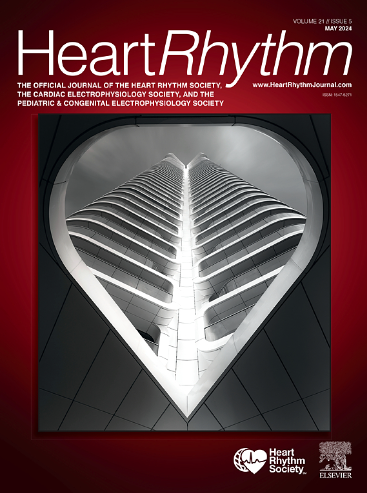2021 年欧洲心脏病学会关于经导管主动脉瓣植入术患者原有右束支传导阻滞指南的临床验证。
IF 5.7
2区 医学
Q1 CARDIAC & CARDIOVASCULAR SYSTEMS
引用次数: 0
摘要
背景:对接受经导管主动脉瓣植入术(TAVI)的右束支传导阻滞(RBBB)患者进行风险分层仍具有挑战性:评估欧洲心脏病学会(ESC)对接受经导管主动脉瓣植入术的右束支传导阻滞患者进行风险分层的标准:我们回顾性分析了 2011-2023 年间接受 TAVI 的前瞻性入组 RBBB 患者。所有患者在手术前后均可获得表面 12 导联心电图。验证了以下ESC标准:ΔPR间期≥20毫秒、QRS轴改变或一过性高度房室传导阻滞(HAVB) 结果:在1410名接受TAVI手术的患者中,有107名(7.6%)患者记录到预先存在RBBB。平均年龄为(83±5)岁,34%为女性,66%接受了可自行扩张的瓣膜。在这107名预先存在RBBB的患者中,有36人(34%)出现了持续超过24小时的HAVB,并接受了永久起搏器治疗。在其余 71 名患者中,有 16 名患者(23%)在 30 天的随访期间出现了延迟性 HAVB。ESC标准识别出了81%(13/16)在30天随访期间出现延迟性HAVB的患者,而遗漏了3名患者(19%,占整个队列的2.8%)。因此,灵敏度为 81%,阴性预测值为 92%。符合ESC标准的患者在30天随访期间罹患HAVB的几率增加了6倍(OR 6.5,95%-CI 1.84-30.8,P = 0.007):结论:在这批使用现代假体和植入技术进行 TAVI 的原有 RBBB 患者中,ESC 标准(PR 延长、QRS 轴改变或一过性 HAVB)能正确识别出 4/5 名在 30 天随访期间出现 HAVB 的患者。本文章由计算机程序翻译,如有差异,请以英文原文为准。

Clinical validation of the 2021 European Society of Cardiology guidelines on preexisting right bundle branch block in patients undergoing transcatheter aortic valve implantation
Background
Risk stratification of patients with right bundle branch block (RBBB) undergoing transcatheter aortic valve implantation (TAVI) remains challenging.
Objective
This study aimed to evaluate the European Society of Cardiology (ESC) criteria for risk stratification of RBBB patients undergoing TAVI.
Methods
We retrospectively analyzed prospectively enrolled patients with preexisting RBBB undergoing TAVI between 2011 and 2023. A surface 12-lead electrocardiogram was available before and after the procedure in all patients. The following ESC criteria were validated: ΔPR interval ≥20 ms, QRS axis change, and transient high-degree atrioventricular block (HAVB) <24 hours after TAVI.
Results
Preexisting RBBB was documented in 107 of 1410 patients (7.6%) undergoing TAVI. Mean age was 83 ± 5 years, 34% were female, and 66% received self-expandable valves. Of those 107 patients with preexisting RBBB, 36 (34%) had persistent HAVB lasting longer than 24 hours and received permanent pacemaker therapy. Of the remaining 71 patients, 16 patients (23%) had delayed HAVB during 30 days of follow-up. The ESC criteria identified 81% of patients (13/16) with delayed HAVB during 30-day follow-up while missing 3 patients (19%; 2.8% of the overall cohort). This resulted in a sensitivity of 81% and a negative predictive value of 92%. Meeting the ESC criteria bore a 6-fold increase in the odds for development of HAVB during 30-day follow-up (odds ratio, 6.5; 95% confidence interval, 1.84–30.8; P = .007).
Conclusion
In this large cohort of patients with preexisting RBBB undergoing TAVI with contemporary prosthesis and implantation techniques, the ESC criteria—PR prolongation, QRS axis change, and transient HAVB—correctly identified 4 of 5 patients in whom HAVB developed during 30-day follow-up.
求助全文
通过发布文献求助,成功后即可免费获取论文全文。
去求助
来源期刊

Heart rhythm
医学-心血管系统
CiteScore
10.50
自引率
5.50%
发文量
1465
审稿时长
24 days
期刊介绍:
HeartRhythm, the official Journal of the Heart Rhythm Society and the Cardiac Electrophysiology Society, is a unique journal for fundamental discovery and clinical applicability.
HeartRhythm integrates the entire cardiac electrophysiology (EP) community from basic and clinical academic researchers, private practitioners, engineers, allied professionals, industry, and trainees, all of whom are vital and interdependent members of our EP community.
The Heart Rhythm Society is the international leader in science, education, and advocacy for cardiac arrhythmia professionals and patients, and the primary information resource on heart rhythm disorders. Its mission is to improve the care of patients by promoting research, education, and optimal health care policies and standards.
 求助内容:
求助内容: 应助结果提醒方式:
应助结果提醒方式:


